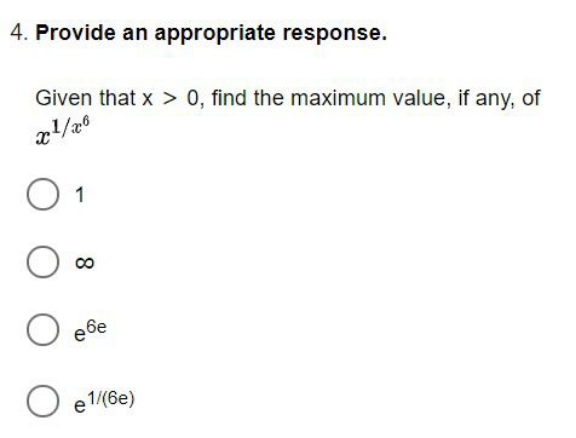Question Number 120243 by benjo_mathlover last updated on 30/Oct/20

Answered by bemath last updated on 30/Oct/20

$${let}\:{f}\left({x}\right)\:=\:{x}^{\frac{\mathrm{1}}{{x}^{\mathrm{6}} }} \:\Leftrightarrow\:\mathrm{ln}\:{f}\left({x}\right)=\:\frac{\mathrm{ln}\:\left({x}\right)}{{x}^{\mathrm{6}} } \\ $$$${differentiating}\:{both}\:{sides}\:{gives} \\ $$$$\frac{{f}\:'\left({x}\right)}{{f}\left({x}\right)}\:=\:\frac{{x}^{\mathrm{5}} −\mathrm{6}{x}^{\mathrm{5}} \mathrm{ln}\:\left({x}\right)}{{x}^{\mathrm{12}} }\:;\:{f}\:'\left({x}\right)=\:\frac{{x}^{\frac{\mathrm{1}}{{x}^{\mathrm{6}} }} .{x}^{\mathrm{5}} \left(\mathrm{1}−\mathrm{6ln}\:\left({x}\right)\right)}{{x}^{\mathrm{12}} } \\ $$$${f}\:'\left({x}\right)\:=\:\frac{{x}^{\frac{\mathrm{1}}{{x}^{\mathrm{6}} }} \left(\mathrm{1}−\mathrm{6ln}\:{x}\right)}{{x}^{\mathrm{7}} } \\ $$$${taking}\:{f}\:'\left({x}\right)=\mathrm{0}\:,\:{we}\:{get}\:\mathrm{ln}\:{x}=\frac{\mathrm{1}}{\mathrm{6}}\:{or}\:{x}={e}^{\frac{\mathrm{1}}{\mathrm{6}}} \\ $$$${curve}\:{increasing}\:{on}\:\mathrm{0}<{x}<{e}^{\frac{\mathrm{1}}{\mathrm{6}}} \:{and}\: \\ $$$${decreasing}\:{on}\:{x}\:>{e}^{\frac{\mathrm{1}}{\mathrm{6}}} .\:{Thus}\:{maximum} \\ $$$${value}\:{is}\:\left({e}^{\frac{\mathrm{1}}{\mathrm{6}}} \right)^{\frac{\mathrm{1}}{{e}}} =\:{e}^{\frac{\mathrm{1}}{\mathrm{6}{e}}} \\ $$
